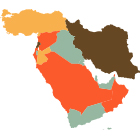Understanding Gender in Northeast Syria - Mercy Corps
Background:
Entering its twelfth year, the Syrian crisis stands as one of the most enduring and intricate humanitarian challenges. This protracted conflict has left no corner of the country untouched, impacting civilian infrastructure and lives significantly. With over half of Syria’s population displaced, including 6.2 million internally displaced individuals, and a staggering 14.6 million people requiring humanitarian aid, the situation reached a critical juncture in 2022, as indicated in the report by the United Nations Secretary-General. Simultaneously, the Syrian crisis led to an economic recession, resulting in extensive damage to essential infrastructure and making civilians even more vulnerable. United Nations estimates suggest that the civil conflict had inflicted nearly $400 billion in economic losses and infrastructure damage by 2018. These cumulative crises have severely depleted the population’s ability to employ positive coping mechanisms, forcing them to resort to negative survival strategies. Northeast Syria has experienced particularly tumultuous years, with cities like Raqqa changing hands multiple times since the onset of the Syrian conflict in 2011.
An urgent gender analysis is needed to understand how shifting needs, coping strategies, decision-making processes, participation levels, and access to rights, security, and humanitarian support have affected gender relations within households and communities in this context. This assessment aims to inform Mercy Corps Northeast Syria (NES) programming and provide recommendations on integrating gender perspectives into sectoral initiatives such as Food Security and Livelihood, Basic Needs (including cash-based interventions), Social Cohesion, and WASH. Furthermore, it seeks to enhance the understanding of how harmful gender norms contribute not only to gender inequality but also to fueling conflict, wider discrimination, exclusion, and violence in this region.
Triangle’s Assignment:
- Gender-Specific Vulnerabilities: The prolonged conflict, displacement, economic recession, and the COVID-19 pandemic had heightened gender-specific risks. During this period, women and girls faced increased threats of various forms of gender-based violence, including physical, sexual, and economic abuse.
- Impact on Health and Well-being: Syrian women and girls encountered numerous health hazards, including limited access to healthcare services and considerable mental health strains. Gender-based violence further exacerbated their vulnerabilities.
- Female-Led Households: As a consequence of the war, a significant number of Syrian households, particularly in Northeast Syria, were led by women. This shift in family dynamics presented its own unique set of challenges.
- Mercy Corps Study: Mercy Corps commissioned this study to comprehend the evolving gender relations, needs, coping strategies, decision-making processes, and access to rights and humanitarian support among men, women, boys, and girls in Northeast Syria.
- Methodological Framework: The study employed a mixed-methods approach, involving primary data collection through surveys, focus group discussions, and key informant interviews, coupled with a comprehensive review of secondary data. It encompassed various population groups in Northeast Syria, contributing to targeted responses and evidence-based recommendations.
Project:
Understanding Gender in Northeast Syria – Mercy Corps

Duration:
October 2021-January 2022
Syria
